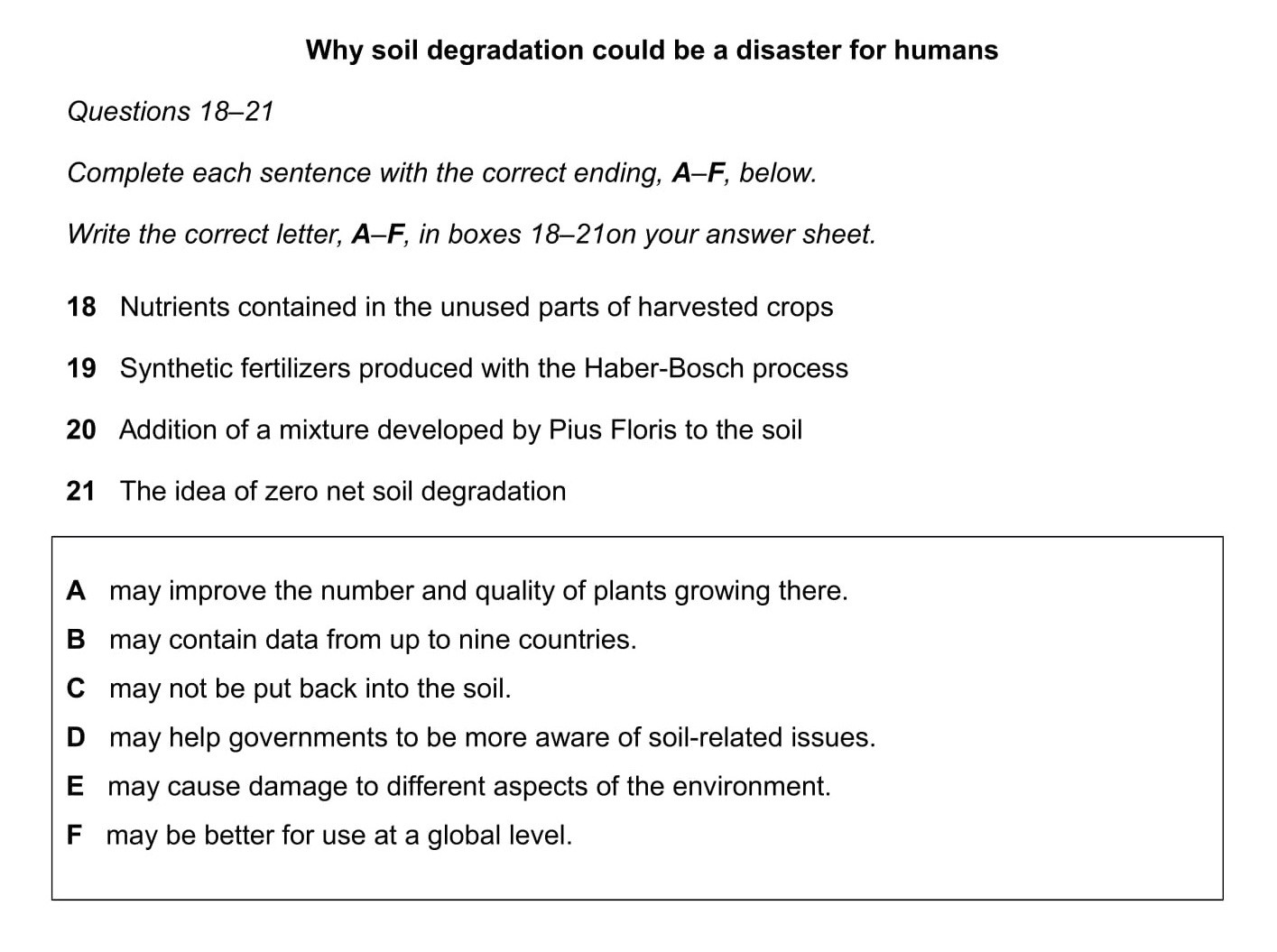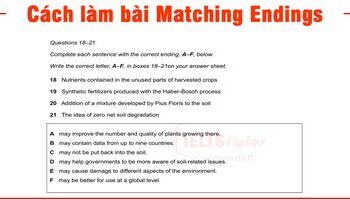Matching Ending – IELTS Reading là dạng bài không xuất hiện nhiều nhưng bạn đừng ngó lơ nếu không luyện tập và nắm chắc kiến thức thì có thể sẽ khiến bạn mất điểm trong bài thi đó nhé.
Xem video nha:
Format IELTS Reading Matching endings
Trong dạng câu hỏi Matching Endings này, sẽ có một list các câu thiếu mất phần ending và một list các ending. Nhiệm vụ của thí sinh là nối các câu chưa hoàn chỉnh với một ending phù hợp dựa trên nội dung của bài đọc.
Mục đích của dạng bài này để kiểm tra mức độ hiểu cách liên kết các ý trong câu theo ý chính của bài đọc.
Format đề:
 Các bước làm bài
Các bước làm bài
Bước 1: Gạch chân từ khóa trong câu hỏi
Bước 2: Tìm từ khóa trong bài đọc theo thứ tự
Bước 3: Gạch chân từ khóa trong Endings
Bước 4: Chọn đáp án đúng
Bước 5: Check lại ngữ pháp và chính tả
Phân tích cách làm bài
| Bước 1 | Gạch chân từ khóa trong câu hỏi Từ khóa (keywords) có 2 dạng: từ khóa có thể thay đổi (changeable keywords) và từ khoá bất biến (unchangeable keywords). · Các từ khóa có thể biến đổi là những từ khóa có khả năng bị paraphrase, các (cụm) danh từ, động từ, tính từ … · Các từ khóa bất biến là những từ khóa không bị biến đổi như các tên riêng, tên khoa học, con số, dữ liệu, ngày tháng … Ví dụ: gạch chân các keywords trong các cụm từ dưới đây: 1. The ancient species of crocodile ate marine creatures that 2. The geology of southern Germany |
| Bước 2
Bước 3
Bước 4
Bước 5 | Tìm từ khóa trong bài đọc theo thứ tự Trong trường hợp không tìm thấy từ khóa ta cần nghĩ ngay đến trường hợp là từ đồng nghĩa (synonym) hoặc cách diễn đạt khác (paraphrase) của keywords. Ví dụ: Gạch chân các keywords đã tìm được ở trên, hoặc synonym, paraphase của keywords trong đoạn văn sau. Đoạn A: The ancestor (= ancient species) of today's crocodiles (= crocodiles) belonged to a group of animals that developed a tail fin and paddle-like limbs for life in the sea, resembling dolphins more than crocodiles. These slender animals, which fed on (=ate) fast-moving prey such as squid and small fish (= marine creatures), lived during the Jurassic era in shallow seas and lagoons in what is now Germany. Đoạn B: Dr Mark Young, of the University of Edinburgh's School of GeoSciences, who took part in the study, said: "The rock formations of southern Germany (= the geology of southern Germany) continue to give us fresh insights into the age of dinosaurs. These rock layers were deposited at a time when Europe was covered by a shallow sea, with countries such as Germany and the UK being a collection of islands." Gạch chân từ khóa trong Endings Ví dụ: Cho các list endings sau, gạch chân các từ khóa quan trọng: A. is believed to be 150 million years ago. B. resembled dolphins. C. was laid down when the area was under water. D. swam fast through the water. Chọn đáp án đúng Trong đoạn có chứa từ “fed on” bằng nghĩa với “ate”. Sau fed on là “fast-moving prey such as squid and small fish”. Vậy ta loại được Endings A và C vì không có thông tin. A. is believed to be 150 million years ago. C. was laid down when the area was under water. Loại A và C. Còn lại 2 Endings: B. resembled dolphins. (giống cá heo) D. swam fast through the water. (bơi nhanh trong nước) fast-moving prey such as squid and small fish = những con mồi di chuyển nhanh như mực hoặc những loại cá nhỏ Ta thấy: fed on fast-moving prey such as squid and small fish = ate marine creatures that swam fast through the water Vậy đáp án cho câu 1 là D. swam fast through the water Tư duy loại trừ đáp án tương tự, ta có thể thấy: The rock formations of southern Germany (= the geology of southern Germany) continue to give us fresh insights into the age of dinosaurs. These rock layers were deposited at a time when Europe was covered by a shallow sea. … deposited when Europe was covered by a shallow sea = was laid down when the area was under water. Vậy đáp án đúng cho câu 2 là C. Check lại ngữ pháp và chính tả Sau đi chốt đáp án xong, câu hoàn chỉnh sẽ là 1. The ancient species of crocodile ate marine creatures that swam fast through the water. Chúng ta thấy thì quá khứ đơn được hòa hợp giữa vế trước và vế sau (ate và swam) 2. The geology of southern Germany was laid down when the region was covered under the water. Chúng ta thấy thì quá khứ đơn được hòa hợp giữa vế trước và vế sau, chủ ngữ geology được chia ở dạng số ít. (was) Nên đây là 100% đáp án chính xác. |
Check- up 1
Grimm’s Fairy Tales
Given that the origins of many of the Grimm fairy tales reach throughout Europe and into the Middle East and Orient, the question must be asked: How German are the Grimm tales? Very, says scholar Heinz Rolleke. Love of the underdog, rustic simplicity, creative energy—these are Teutonic traits. The coarse texture of life during medieval times in Germany, when many of the tales entered the oral tradition, also coloured the narratives. Throughout Europe children were often neglected and abandoned, like Hansel and Gretel. Accused witches were burned at the stake, like the evil mother-in- law in "The Six Swans". "The cruelty in the stories was not the Grimms' fantasy", Rolleke points out. "It reflected the law-and-order system of the old times".
The editorial fingerprints left by the Grimms betray the specific values of 19th-century Christian, bourgeois German society. But that has not stopped the tales from being embraced by almost every culture and nationality in the world. What accounts for this widespread, enduring popularity? Bernhard Lauer points to the "universal style" of the writing. "You have no concrete descriptions of the land, or the clothes, or the forest, or the castles. It makes the stories timeless and placeless." "The tales allow us to express 'our utopian longings'," says lack Zipes of the University of Minnesota, whose 1987 translation of the complete fairy tales captures the rustic vigour of the original text. "They show a striving for happiness that none of us knows but that we sense is possible. We can identify with the heroes of the tales and become in our mind the masters and mistresses of our own destinies. "
Complete each sentence with correct ending, A—H, below. Write the correct letter, A—H, in boxes 36-38 on your answer sheet.
36. Heinz Rolleke said the Grimm’s tales are “German” because the tales
37. Heinz Rolleke said the abandoned children in tales
38. Bernhard Lauer said the writing style of the Grimm brothers is universal because they
List of endings:
A. reflect what life was like at that time.
B. help children deal with their problems.
C. demonstrate the outdated system.
D. tell of the simplicity of life in the German countryside.
E. contribute to the belief in nature power.
F. avoid details about characters’ social settings.
Các bước làm bài:
Bước 1: Gạch chân từ khóa trong câu hỏi
Bước 2: Tìm từ khóa trong bài đọc theo thứ tự
Bước 3: Gạch chân từ khóa trong Endings
Bước 4: Chọn đáp án đúng
Bước 5: Check lại ngữ pháp và chính tả
Các mẹo làm bài Matching endings
Mẹo 1: Câu trả lời theo trật tự đoạn văn. Vì vậy đáp án cho câu 2 sẽ sau đáp án câu 1.
Mẹo 2: Đọc đề (incomplete sentence) trước khi bạn đọc (endings) hoặc bài văn. Có nhiều endings nên sẽ phí thời gian để đọc hết endings trước.
Mẹo 3: Nghĩ những cụm từ đồng nghĩa và cách viết lại (paraphrase) từ vựng trong đề trước khi đọc đoạn văn.
Mẹo 4: Dùng nhiều thời gian với câu hỏi đầu tiên bởi vì đây là câu hỏi khó nhất. bạn có nhiều lựa chọn khác nhau cho câu hỏi đầu tiên và chắc chắn sẽ khiến bạn mất nhiều thời gian. Câu hỏi cuối mất ít nhiều thời gian vì bạn còn ít lựa chọn hơn.
Mẹo 5: Vế đầu và vế sau ko hòa hợp về ngữ pháp thì khả năng cao đây là đáp án sai.
Áp dụng các mẹo vào bài đọc:
A. The ancestor of today's crocodiles belonged to a group of animals that developed a tail fin and paddle-like limbs for life in the sea, resembling dolphins more than crocodiles. These slender animals, which fed on fast-moving prey such as squid and small fish, lived during the Jurassic era in shallow seas and lagoons in what is now Germany.
B. Dr Mark Young, of the University of Edinburgh's School of GeoSciences, who took part in the study, said: "The rock formations of southern Germany continue to give us fresh insights into the age of dinosaurs. These rock layers were deposited at a time when Europe was covered by a shallow sea, with countries such as Germany and the UK being a collection of islands."
Complete each sentence with the correct ending, below.
1. The ancient species of crocodile ate marine creatures that
2. The geology of southern Germany
List of endings:
A. is believed to be 150 million years ago.
B. resembled dolphins.
C. was laid down when the area was under water.
D. swam fast through the water.
| Mẹo 1: Câu trả lời theo trật tự đoạn văn. | The ancient species of crocodile xuất hiện trước trong bài đọc và trong câu hỏi, rồi sau đó mới đến thông tin về geology of southern Germany, nên ta có thể tìm câu trả lời của câu 2 ở đoạn sau đoạn 1. |
| Mẹo 2: Đọc đề (incomplete sentence) trước khi bạn đọc (endings) hoặc bài văn. Có nhiều endings nên sẽ phí thời gian để đọc hết endings trước. | Số lượng endings trong bài thường sẽ nhiều hơn số lượng câu chưa hoàn chỉnh. Trong ví dụ trên, số lượng câu là 2 và số endings là 4. |
| Mẹo 3: Nghĩ những cụm từ đồng nghĩa và cách viết lại (paraphrase) từ vựng trong đề trước khi đọc đoạn văn.
| Ancient species: ancestor, prehistory … Marine creatures: fish, squid, turtle, sea animals, animals that live in water … Geology: rock, soil … |
| Mẹo 4: Dùng nhiều thời gian với câu hỏi đầu tiên bởi vì đây là câu hỏi khó nhất. | Khi bắt đầu làm, câu đầu tiên ta phải chọn 1 trong 4 lựa chọn, sẽ khó hơn và mất nhiều thời gian hơn khi làm câu 2, khi chỉ phải chọn 1 trong 3 lựa chọn. |
| Mẹo 5: Vế đầu và vế sau ko hòa hợp về ngữ pháp thì khả năng cao đây là đáp án sai. | Câu 1. The ancient species of crocodile ate marine creatures that Có thể loại ngay đáp án C và A vì creatures số nhiều không đi với động từ chia số ít. |
Check- up 2
What is meaning?
[…] Words and word meanings are one of the most important information cues used in speaking and understanding, as well as in reading. Indeed, a person’s life experience and cultural experience (even reading comic strips) are most relevant to the development of linguistic “meaning making” in any language, which is very important in the communication process. Words from a person’s native language and culture perspective can carry special associations. For instance, the Spanish words for hammock, tobacco, and potato are derived from Tamo words for these items. Therefore, when people’s semantic habits are reasonably similar to those of most people around them, they are regarded as “normal” or perhaps “dull”. If their semantic habits are noticeably different from those of others, they are regarded as “individualistic” or “original”, or, if the differences are disapproved of or viewed with alarm, as “crazy”.
A definition states the meaning of a word using other words. It is clear that to define a word, as a dictionary does, is simply to explain the word with more words. However,defining words with more words usually gets people (especially children) at once into what mathematicians call an “infinite regress”, an infinite series of occurrences or concepts. For example, it can lead people into the kind of run-around that people sometimes encounter when they look up “impertinence” and find it defined as “impudence”, so they look up “impudence” and find it defined as “impertinence”. Yet—and here we come to another common reaction pattern— people often act as if words can be explained fully with more words. To a person who asked for a definition of jazz, Louis Armstrong is said to have replied, “If you have to ask what jazz is, you’ll never know”, proving himself to be an intuitive semanticist as well as a great trumpet player.
Semantics, then, seeks the “operational” definition instead of the dictionary Bridgman, the 1946 Nobel Prize winner and physicist, once wrote, “The true meaning of a term is to be found by observing what a man does with it, not by what he says about it.” He made an enormous contribution to science by showing that the meaning of a scientific term lies in the operations, the things done, that establish its validity, rather than in verbal definitions. An example of operational definition of the term “weight” of an object, operationalized to a degree, would be the following: “weight is the numbers that appear when that object is placed on a weighing scale”. According to it, when one starts reading the numbers on the scale, it would more fully make an operational definition. But if people say—and revolutionists have started uprisings with just this statement “Man is born free, but everywhere he is in chains!”—what operations could we perform to demonstrate its accuracy or inaccuracy? […]
Questions 36 - 40
Complete each sentence with the correct ending, below. Write the correct letter, A-H, in boxes 36-40 on your answer sheet.
36. A comic strip
37. A dictionary
38. Bridgman
List of endings:
A. is meaningless.
B. can have a lasting effect on human behaviour.
C. is a symbol that has lost its meaning.
D. can be understood only in its social context.
E. can provide only an inadequate definition of meaning.
F. reflects the variability of human behaviours.
G. emphasizes the importance of analyzing how words were used .
H. suggests that certain types of behaviour carry more meaning than others.
Luyện tập có đáp án
Passage 1:
Book review on Musiccophilia
Norman M. Weinberger reviews the latest work of Oliver Sacks.
A. Music and the brain are both endlessly fascinating subjects, and as a neuroscientist specialising in auditory learning and memory, I find them especially intriguing. So I had high expectations of Musicophilia, the latest offering from neurologist and prolific author Oliver Sacks. And I confess to feeling a little guilty reporting that my reactions to the book are mixed.
B. Sacks himself is the best part of Musicophilia. He richly documents his own life in the book and reveals highly personal experiences. The photograph of him on the cover of the book- which shows him wearing headphones, eyes closed, clearly enchanted as he listens to Alfred Brendel perform Beethoven’s Pathetique Sonata-makes a positive impression that is home out by the contents of the book. Sacks’s voice throughout is steady and erudite but never pontifical. He is neither self- conscious nor self-promoting.
C. The preface gives a good idea of what the book will deliver. In it Sacks explains that he wants to convey the insights gleaned from the “enormous and rapidly growing body of work on the neural underpinnings of musical perception and imagery, and the complex and often bizarre disorders to which these are prone.” He also stresses the importance of “the simple art of observation” and “the richness of the human context.” He wants to combine “observation and description with the latest in technology,” he says, and to imaginatively enter into the experience of his patients and subjects. The reader can see that Sacks, who has been practicing neurology for 40 years, is tom between the ‘ old-fashioned path o observation and the new fangled, high-tech approach: He knows that he needs to take heed of the latter, but his heart lies with the former.
D. The book consists mainly of detailed descriptions of cases, most of them involving patients whom Sacks has seen in his practice. Brief discussions of contemporary neuroscientific reports are sprinkled liberally throughout the text. Part, “Haunted by Music,” begins with the strange case of Tony Cicoria, a nonmusical, middle-aged surgeon who was consumed by a love of music after being hit by lightning. He suddenly began to crave listening to piano music, which he had never cared for in the past. He started to play the piano and then to compose music, which arose spontaneously in his mind in a “torrent” of notes. How could this happen? Was the cause psychological? (He had had a near-death experience when the lightning struck him.) Or was it the direct result of a change in the auditory regions of his cerebral cortex? Electroencephalography (EEG) showed his brain waves to be normal in the mid-1990s, just after his, trauma and subsequent “conversion” to music. There are now more sensitive tests, but Cicoria, has declined to undergo them; he does not want to delve into the causes of his musicality. What a shame!
E. Part II, “A Range of Musicality,” covers a wider variety of topics, but unfortunately, some of the chapters offer little or nothing that is new. For example, chapter 13, which is five pages long, merely notes that the blind often have better hearing than the sighted. The most interesting chapters are those that present the strangest cases. Chapter 8 is about “amusia,” an inability to hear sounds as music, and “dysharmonia,” a highly specific impairment of the ability to hear harmony, with the ability to understand melody left intact. Such specific “dissociations” are found throughout the cases Sacks recounts.
F. To Sacks’s credit, part III, “Memory, Movement and Music,” brings us into the underappreciated realm of music therapy. Chapter 16 explains how “melodic intonation therapy” is being used to help expressive aphasic patients (those unable to express their thoughts verbally following a stroke or other cerebral incident) once again become capable of fluent speech. In chapter 20, Sacks demonstrates the near-miraculous power of music to animate Parkinson’s patients and other people with severe movement disorders, even those who are frozen into odd postures. Scientists cannot yet explain how music achieves this effect.
G. To readers who are unfamiliar with neuroscience and music behavior, Musicophilia may be something of a revelation. But the book will not satisfy those seeking the causes and implications of the phenomena Sacks describes. For one thing, Sacks appears to be more at ease discussing patients than discussing experiments. And he tends to be rather uncritical in accepting scientific findings and theories.
H. It’s true that the causes of music-brain oddities remain poorly understood. However, Sacks could have done more to draw out some of the implications of the careful observations that he and other neurologists have made and of the treatments that have been successful. For example, he might have noted that the many specific dissociations among components of music comprehension, such as loss of the ability to perceive harmony but not melody, indicate that there is no music center in the brain. Because many people who read the book are likely to believe in the brain localisation of all mental functions, this was a missed educational opportunity.
I. Another conclusion one could draw is that there seem to be no “cures” for neurological problems involving music. A drug can alleviate a symptom in one patient and aggravate it in another, or can have both positive and negative effects in the same patient. Treatments mentioned seem to be almost exclusively antiepileptic medications, which “damp down” the excitability of the brain in general; their effectiveness varies widely.
J. Finally, in many of the cases described here the patient with music-brain symptoms is reported to have “normal” EEG results. Although Sacks recognises the existence of new technologies, among them far more sensitive ways to analyze brain waves than the standard neurological EEG test, he does not call for their use. In fact, although he exhibits the greatest compassion for patients, he conveys no sense of urgency about the pursuit of new avenues in the diagnosis and treatment of music-brain disorders. This absence echoes the book’s preface, in which Sacks expresses fear that “the simple art of observation may be lost” if we rely too much on new technologies. He does call for both approaches, though, and we can only hope that the neurological community will respond.
Questions 37-40
Complete each sentence with the correct ending, A-F, below. Write correct letter, A-F, in boxes 37-40 on your answer sheet
37. The content covered dissociations in understanding between harmony and melody.
38. The study of treating musical disorders.
39. The EEG scans of Sacks’s patients.
40. Sacks believes testing based on new technologies.
List of endings:
A. show no music-brain disorders.
B. indicates that medication can have varied results,
C. is key for the neurological community to unravel the mysteries.
D. should not be used in Isolation.
E. indicate that not everyone can receive good education.
F. show a misconception that there is function centre localized in the brain
Đáp án:
Check-up 1:
36. Đáp án: D
Thông tin của câu hỏi này nằm ở câu văn thứ 2 của đoạn văn thứ 7 “How German are the Grimm tales? Very, says scholar Heinz Rolleke. Love of the underdog, rustic simplicity, creative energy”. Trong các đáp án đưa ra, tell of the simplicity of life in the German countryside là thành phần hợp lý nhất để nối vào vế đã cho.
37. Đáp án: A
Trong câu văn cuối của đoạn văn 7, tác giả đề cập đến việc trẻ em bị bỏ rơi và việc hành hình tội phạm như một điều hiển nhiên – là trật tự xã hội vào thời điểm đó. Thế nên, reflect what life was like at that time là thành phần hợp lý nhất để nối vào vế đã cho.
38. Đáp án: F
Bernhard Lauer, trong đoạn văn thứ 8, đã khẳng định tính “toàn cầu” của truyện cổ Grimm là nhờ việc chúng không chỉ rõ một địa điểm hay thời gian nào cụ thể, giúp những truyện này sống mãi với thời gian và phù hợp với mọi hoàn cảnh. Chúng ta đọc lại đoạn văn "You have no concrete descriptions of the land, or the clothes, or the forest, or the castles. It makes the stories timeless and placeless" để thấy được khẳng định của người này.
Check-up 2:
36. Đáp án: B
Thông tin cho câu hỏi nằm ở đoạn văn thứ 2. Tác giả khẳng định rằng những trải nghiệm của con người có ảnh hưởng tới cách mà chúng ta phát triển và tiếp nhận ngôn ngữ. Trong những trải nghiệm đó người này có nhắc đến việc đọc truyện tranh (comic strips).
37. Đáp án: E
Thông tin cho câu hỏi nằm ở câu đầu tiên đoạn thứ 3 của bài. Tác giả khẳng định rằng một cuốn tử điển chỉ có thể cung cấp một lượng ngữ nghĩa giới hạn, vì chúng thường giải nghĩa bằng cách sử dụng các từ đồng nghĩa có tính tương đương chứ không đi sâu vào chi tiết được. Chúng ta xem lại câu văn “A definition states the meaning of a word using other words. It is clear that to define a word, as a dictionary does, is simply to explain the word with more words”
38. Đáp án: G
Thông tin cho câu hỏi nằm ở đoạn văn thứ 4 của bài. Tác giả lấy dẫn chứng về nhà nghiên cứu Bridman giải nghĩa từ weight (cân nặng) và câu nói Man is born free, but everywhere he is in chains (Con người được sinh ra tự do, nhưng khắp nơi họ phải sống kiếp nô lệ) để chỉ ra rằng ngữ nghĩa của từ đa dạng với từng hoàn cảnh nói. Vì vậy việc hiểu được chúng trong từng ngữ cảnh là rất quan trọng.
Passage 1:
37. Đáp án: F
Thông tin cho câu hỏi nằm ở đoạn văn H “For example, he might have noted that the many specific dissociations among components of music comprehension, such as loss of the ability to perceive harmony but not melody, indicate that there is no music center in the brain”.
38. Đáp án: B
Thông tin cho câu hỏi nằm ở đoạn văn B “A drug can alleviate a symptom in one patient and aggravate it in another, or can have both positive and negative effects in the same patient”.
39. Đáp án: A
Thông tin cho câu hỏi nằm ở đầu đoạn văn J “Finally, in many of the cases described here the patient with music-brain symptoms is reported to have ‘normal’ EEG results”.
40. Đáp án: D
Thông tin cho câu hỏi nằm ở đoạn cuối đoạn văn J “This absence echoes the book’s preface, in which Sacks expresses fear that “the simple art of observation may be lost” if we rely too much on new technologies. He does call for both approaches, though, and we can only hope that the neurological community will respond”.
Trên đây là bài học về Matching endings các bạn lưu ý các mẹo để làm bài tốt hơn nhé.
Bài phân tích đề thi thật, thực hiện bởi IELTS Fighter, vui lòng ghi nguồn nếu sử dụng chia sẻ. Xin cảm ơn.
Xem thêm bài học:
IELTS Reading: Chiến thuật làm bài MATCHING INFORMATION
IELTS Reading: Chiến thuật làm bài MATCHING HEADINGS





